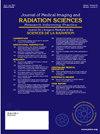Altered reward circuit in adolescents with non-suicidal self-injury: a study on subcortical volume and lateralization index
IF 1.3
Q3 RADIOLOGY, NUCLEAR MEDICINE & MEDICAL IMAGING
Journal of Medical Imaging and Radiation Sciences
Pub Date : 2024-10-01
DOI:10.1016/j.jmir.2024.101521
引用次数: 0
Abstract
Purpose
This study aims to examine the structural characteristics of the reward circuit in adolescents with non-suicidal self-injury (NSSI), focusing on subcortical volume and lateralization index (LI). The objective is to shed light on the underlying mechanisms of NSSI within the reward circuits and provide structural evidence supporting its occurrence.
Methods
A total of 50 adolescents with first-episode NSSI and 33 healthy controls (HC) were enrolled. Clinical characteristics included the Self-Rating Anxiety Scale (SAS), Beck Scale for Suicidal Ideation (BSI), Brief Assessment of Cognition in Schizophrenia (BACS), and Ottawa Self-Injury Inventory (OSI). Subcortical volume segmentation was performed using Freesurfer software. LI quantified differences in left and right subcortical volume. Statistical analysis of clinical features, subcortical volume, and LI was performed using analysis of covariance, Wilcoxon rank-sum test, and independent sample t-tests. Pearson or Spearman correlation was used to explore relationships between subcortical volume or LI and clinical characteristics.
Results
The NSSI group had higher SAS scores compared to the HC group. BACS scores in the NSSI group were lower than in the HC group. Compared to the HC group, the NSSI group exhibited reduced volume in the left accumbens, along with an increased LI of the accumbens. In the NSSI group, left accumbens volume was positively correlated with BACS scores, and LI of the accumbens was negatively correlated with BACS scores.
Conclusion
This study discovered a decrease in the volume of the left accumbens in adolescents with NSSI, providing structural evidence that supports the involvement of reward circuits in NSSI among adolescents. The observed alterations in subcortical volume and LI suggest a potential vulnerability in the left hemisphere among adolescents with NSSI.
非自杀性自伤青少年奖赏回路的改变:皮层下体积和侧化指数研究
目的 本研究旨在探讨非自杀性自伤(NSSI)青少年奖赏回路的结构特征,重点是皮层下体积和侧化指数(LI)。目的是揭示奖赏回路中 NSSI 的潜在机制,并提供支持其发生的结构证据。临床特征包括焦虑自评量表(SAS)、贝克自杀意念量表(BSI)、精神分裂症认知简评(BACS)和渥太华自伤量表(OSI)。皮层下容积分割使用 Freesurfer 软件进行。LI量化了左右皮层下体积的差异。采用协方差分析、Wilcoxon 秩和检验和独立样本 t 检验对临床特征、皮层下容积和 LI 进行统计分析。皮层下容积或LI与临床特征之间的关系采用皮尔逊或斯皮尔曼相关性分析。NSSI 组的 BACS 分数低于 HC 组。与 HC 组相比,NSSI 组的左侧腰果体积减小,腰果的 LI 增加。在 NSSI 组中,左侧延脑体积与 BACS 评分呈正相关,而延脑 LI 与 BACS 评分呈负相关。所观察到的皮层下体积和左侧奖赏回路的改变表明,患有 NSSI 的青少年的左半球存在潜在的脆弱性。
本文章由计算机程序翻译,如有差异,请以英文原文为准。
求助全文
约1分钟内获得全文
求助全文
来源期刊

Journal of Medical Imaging and Radiation Sciences
RADIOLOGY, NUCLEAR MEDICINE & MEDICAL IMAGING-
CiteScore
2.30
自引率
11.10%
发文量
231
审稿时长
53 days
期刊介绍:
Journal of Medical Imaging and Radiation Sciences is the official peer-reviewed journal of the Canadian Association of Medical Radiation Technologists. This journal is published four times a year and is circulated to approximately 11,000 medical radiation technologists, libraries and radiology departments throughout Canada, the United States and overseas. The Journal publishes articles on recent research, new technology and techniques, professional practices, technologists viewpoints as well as relevant book reviews.
 求助内容:
求助内容: 应助结果提醒方式:
应助结果提醒方式:


